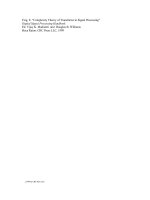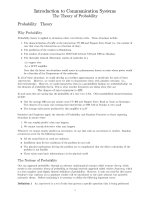contemporary theory of conservation (2005) yyepg lotb
Bạn đang xem bản rút gọn của tài liệu. Xem và tải ngay bản đầy đủ của tài liệu tại đây (1.99 MB, 257 trang )
TeAM
YYeP
G
Digitally signed by
TeAM YYePG
DN: cn=TeAM YYePG,
c=US, o=TeAM YYePG,
ou=TeAM YYePG,
email=
Reason: I attest to the
accuracy and integrity
of this document
Date: 2005.05.03
03:10:28 +08'00'
Contemporary Theory of
Conservation
Prelims.qxd 3~9~04 9:33 Page i
Prelims.qxd 3~9~04 9:33 Page ii
Contemporary Theory of
Conservation
Salvador Muñoz Viñas
AMSTERDAM BOSTON HEIDELBERG LONDON NEW YORK OXFORD
PARIS SAN DIEGO SAN FRANCISCO SINGAPORE SYDNEY TOKYO
Prelims.qxd 3~9~04 9:33 Page iii
Elsevier Butterworth-Heinemann
Linacre House, Jordan Hill, Oxford OX 2 8DP
30 Corporate Drive, Burlington, MA 01803
First published 2005
Copyright © 2005, Elsevier Ltd. All rights reserved
No part of this publication may be reproduced in any material form (including
photocopying or storing in any medium by electronic means and whether or
not transiently or incidentally to some other use of this publication) without
the written permission of the copyright holder except in accordance with the
provisions of the Copyright, Designs and Patents Act 1988 or under the terms
of a licence issued by the Copyright Licensing Agency Ltd, 90 Tottenham
Court Road, London, England W1T 4LP. Applications for the copyright
holder’s written permission to reproduce any part of this publication should
be addressed to the publisher
Permissions may be sought directly from Elsevier’s Science and Technology
Rights Department in Oxford, UK: phone: (ϩ44) (0) 1865 843830;
fax: (ϩ44) (0) 1865 853333; e-mail: You may
also complete your request on-line via the Elsevier homepage
(www.elsevier.com), by selecting ‘Customer Support’ and then
‘Obtaining Permissions’
British Library Cataloguing in Publication Data
A catalogue record for this book is available from the British Library
Library of Congress Cataloguing in Publication Data
A catalogue record for this book is available from the Library of Congress
ISBN 0 7506 6224 7
Typeset by Charon Tec Pvt. Ltd, Chennai, India
Printed and bound in Great Britain
For information on all Elsevier Butterworth-Heinemann
publications visit our website at
Prelims.qxd 3~9~04 9:33 Page iv
Contents
Acknowledgements ix
Preface xi
1 What is conservation? 1
A brief history of conservation 1
Issues in the definition of conservation 7
Too many tasks 7
Too many objects 8
Too many professionals 9
Conservators’ conservation 13
A note on the use of the terms 14
Preservation and restoration 15
Preservation 15
Restoration 16
Preservation and restoration act together 18
Preservation and restoration are different 19
Preventive and informational preservation 21
Preventive preservation 21
Informational preservation 23
2 The objects of conservation 27
What shall be conserved? 27
The Mustang paradox 27
The evolution of conservation objects 29
Problems of traditional categories 31
Art, archaeology and antiquities 31
Historic works 35
Prelims.qxd 3~9~04 9:33 Page v
vi Contents
Riegl’s ‘monuments’ 36
Heritage 37
The nihilist turn 41
The communicative turn 43
What is a symbol? 45
Webs of meaning 46
Too many symbols 50
Refining the communicative turn 50
Symbolic strength as a criterion 50
Which meanings make up a conservation object? 51
Mechanisms of symbolization 55
Changing meanings 57
Two exceptions: Riegl’s ‘deliberate monuments’
and recent artworks 58
Ethno-historical evidence 59
Summing up 62
3 Truth, objectivity and scientific conservation 65
The pursuit of truth in classical theories of conservation 65
Aestheticist theories 67
Scientific conservation 69
An observation on the role of architects
in conservation theory 71
What is ‘scientific conservation’? 74
The (missing) theoretical body of scientific
conservation 78
The principles of scientific conservation 81
Material fetichism 82
Belief in scientific enquiry 87
The pragmatic argument 88
Summing up 89
4 The decline of truth and objectivity 91
The tautological argument: authenticity and truth
in conservation objects 91
Legibility 99
Prelims.qxd 3~9~04 9:33 Page vi
Contents vii
The notion of damage under scrutiny 101
The argument of unsuitability: subjective and
intangible needs in conservation 105
5 A brief excursion into the real world 115
Conservation and science 115
Lack of communication 117
The insufficiency of hard sciences 120
Complexity 120
An infinite variety of objects 125
A vindication of conservators’ technical knowledge 129
Lack of technological knowledge 141
Technoscience 144
6 From objects to subjects 147
Radical subjectivism 147
Re-examining the problem: inter-subjectivism 150
The expert’s zone: objectivism and authority 153
From the experts’ zone to the trading zone: the
emergence of the subject 158
Affected people 158
The stakeholders 160
The trading zone 163
Clashes in meanings: inter- and intra-cultural
issues in conservation 165
7 The reasons for conservation 171
Reasons for conservation 171
From the conservation of truths to the
conservation of meanings 173
Expressive conservation 176
Functional and value-led conservation 177
8 Sustainable conservation 183
The criticism of reversibility 183
Minimum intervention 188
Prelims.qxd 3~9~04 9:33 Page vii
From minimum intervention to maximum benefit 191
The principle of sustainability 194
9 From theory to practice: a revolution of
common sense 199
Discernible restoration 199
Adaptive ethics 202
The risks of negotiatory conservation 205
Evidential conservation 205
Genial conservation 206
Demagogic conservation 208
Exerting authority: the role of the experts in
contemporary conservation 209
Conclusion: a revolution of common sense 212
Bibliographical references 215
Subject index 229
Proper names index 233
Author index 237
viii Contents
Prelims.qxd 3~9~04 9:33 Page viii
Acknowledgements
Contact with other conservators and researchers has indeed been
important in shaping Contemporary Theory of Conservation.
Among these, my colleagues at the Conservation Department in
the Universidad Politécnica de Valencia deserve recognition, as
they have helped me to dare to think. For this same reason, Eugene
F. Farrell and the kind people at Harvard’s Center for Conservation
and Technical Studies (presently the Straus Center for Conser-
vation) also had an influence upon this work.
I would also like to thank Mónica Espí, Emilia Viñas and Diodoro
Muñoz for helping me to find the time to work on this book. This
was a very great help indeed and I will always be grateful for their
patience and generosity.
The support from Suzanne Ruehle and Natalia Gómez did have a
very noticeable influence on the book. Suzanne and Natalia cor-
rected the draft text and made many valuable suggestions – most
of which were willingly accepted by the author. Their competent
and dedicated work has improved this book in many ways.
Thank you all
Salvador Muñoz Viñas
Valencia
ix
Prelims.qxd 3~9~04 9:33 Page ix
Prelims.qxd 3~9~04 9:33 Page x
Preface
… One should make sure at the very outset that there is a truly
philosophic basis so that ‘conservators’ shall not only be good prac-
titioners, but scholars as well, knowing not only what they do, but
why they do it, and prepared to discuss fundamental questions
effectively with their opposite numbers in aesthetics, art history
and so forth. (George Stout, 1945)
This essay deals with contemporary theory of conservation.
Perhaps the boldest thesis in the text is the very idea that a con-
temporary theory of conservation actually exists. No one doubts
that there are a number of schemes, ideas and opinions – of the-
ories or fragments of theories that differ to a greater or lesser
degree from previous ones: they can be found or detected in writ-
ten texts of many kinds (congress abstracts and preprints, periodi-
cals, web pages, charters, etc.), in conversations and in the practice
of conservation itself. However, these ideas could hardly be con-
sidered as a single, organized body of thinking. This book is an
attempt to weave many of these ideas into a coherent theory, and to
reveal patterns that might remain hidden due to their variety.
Stating that a contemporary theory exists implies that one or more
non-contemporary theories exist as well. We might call them ‘clas-
sical theories’, but below this polite term there lies a less neutral
assumption: it is obvious that non-contemporary theories are a
thing of the past.
It therefore seems important to precisely define what we are talking
about. By ‘contemporary’ we mean those ideas about conservation
xi
Prelims.qxd 3~9~04 9:33 Page xi
that have been developed since the 1980s. It might be argued that
this is an arbitrary date, and that several earlier examples of ‘con-
temporary’ conservation thinking do exist. However, these are
exceptions, and so the 1980s must still be considered to be quite
representative. In this decade, the second and third versions of
the Burra charter were published, as well as the first consequential
texts criticizing the principle of reversibility. Also, the notion of
post-modernism became commonplace, with its emphasis on
many ideas that have had a recognizable impact on conservation
theory.
The notion of ‘theory’ is interesting, too. ‘Theory’ is usually
defined by contrasting it with ‘practice’. However, this idea cannot
be applied here. When a conservation teacher explains, for
instance, the effect of a solvent’s surface tension on its dissolving
capabilities when applied to a paint layer, he or she is dealing with
a theoretical topic within the conservation field; however, no one
would consider it to be ‘conservation theory’. ‘Conservation the-
ory’ is most often related to ‘conservation ethics’, although these
notions are not synonyms. This is a convention which, even though
it is very widespread, is still a convention. This book will adhere to
it, since it is communicatively very efficient, but the expression
‘contemporary philosophy of conservation’ would not be inappro-
priate at all. Consequently, conservation ethics, as commonly
understood, will be dealt with here, but, in order to reach this topic,
others must be treated beforehand: first, the activity itself is
defined, and the reasons why it is performed are investigated.
Then, the values that lie behind conservation are examined – they
interact to produce different ‘ethical’ codes of practice. In other
words (which are more complex and unnecessarily pedantic), the
teleological and axiological aspects of conservation are described.
This will all be done in a benevolent manner. First and foremost,
this text is intended to be understood by the reader. It will perhaps
convince some of them, but this is not its main goal. If understood,
xii Preface
Prelims.qxd 3~9~04 9:33 Page xii
it will reveal a coherent pattern behind a plethora of valuable,
apparently unrelated thoughts; it will help the interested reader
know them and know how to interpret them. To achieve this goal,
the text is the result of a compromise between comprehensiveness
and readability. In the next few pages, the reader should be more
involved and intrigued than baffled and impressed. This is an invi-
tation to the reader to enter into the discourse of contemporary
theory of conservation.
Preface xiii
Prelims.qxd 3~9~04 9:33 Page xiii
Prelims.qxd 3~9~04 9:33 Page xiv
1
Chapter 1
What is
conservation?
The first chapter in this book attempts to define conservation in
the most precise way possible, for it is important in any discus-
sion to know what exactly is being discussed. It should also be
useful in clarifying some common misconceptions regarding the
notions of conservation, restoration and preventive conservation.
The precise use of these expressions is a requirement for any
elaboration on conservation theory to be consistent; therefore,
some rules of notation are presented to clarify what is meant at
each moment.
A brief history of conservation
Conservation as we know it today is a complex activity. Since the
nineteenth century, it has broadened in scope, strengthened in
importance and, simply speaking, come of age. It has not always
been this way; just a few decades ago, it was much simpler, and
some decades before that, it did not even exist – it did not exist as
we know it: as a particular activity, requiring special, well-
trained skills, which are different from those of the artist, the
carpenter or the sculptor.
Certainly, the statues of Phidias were cleaned and repaired as
needed; new pieces in the large glass windows of the Cologne
Chap-01.qxd 3~9~04 9:33 Page 1
cathedral were replaced when the old ones were broken; and old
paintings all around the world were routinely varnished when the
colour became too dull. However, the fact that these activities are
now performed by conservators hardly allows us to think of them as
conservation – and thus to believe that conservation, as understood
today, has always existed. It would be far more historically accurate
to call them ‘servicing’, ‘cleaning’, ‘maintenance’ or ‘repairing’.
Conservation began when it became clear that the views,
approaches and skills required to treat a painting were different
from those required to treat the walls of a common peasant
house; or when it was apparent that cleaning a Neolithic axe
required a different attitude and knowledge from that needed to
clean a household lamp. Conservation was born out of this real-
ization, which became widespread sometime between the nine-
teenth and the twentieth century.
This attitude, however, can be traced to previous times, when cer-
tain individuals showed a special appreciation for the objects that
we presently understand as ‘heritage’, and thus recommended
their maintenance with the least possible interference. However,
these cases were exceptions and should not be identified with our
contemporary view of conservation.
Arguably, the most important of these exceptions is that of Pietro
Edwards. In the eighteenth century, Edwards was commissioned
by the authorities of Venice to supervise the refurbishing of
Venetian artworks. As a result, he wrote the Capitolato, a set
of norms to prevent the excesses committed by the restorers of
Venetian paintings. It corresponds to some ideas which are very
close to those that exist today. For example, he mandated the
removal of old inpaintings, the use of ‘non-corrosive’ products,
and stated that no new inpainting should extend beyond the lacuna
it was intended to cover. These ideas, obvious as they may seem
today, were a novelty in 1777 when the Capitolato was written.
2 Contemporary theory of conservation
Chap-01.qxd 3~9~04 9:33 Page 2
Edwards can be viewed either as a pioneer or as an exception. The
Capitolato had no immediate consequences and remained an iso-
lated case for some time. Meanwhile, minds were changing in many
ways. The consolidation of the notion of art within Western soci-
eties, which led to its special appreciation, was one of them. In the
second half of the eighteenth century, Winckelmann wrote his sem-
inal text on art history; fine arts academies became common around
Europe; and Baumgarten formally created the philosophical field of
aesthetics. All of this meant that art, and thus its objects, gained a
special status within society – a status that is still valid today.
In the nineteenth century, the ideas of the enlightenment gained
momentum and wide recognition: science became the primary
way to reveal and avail truths, and public access to culture and art
became an acceptable idea; romanticism consecrated the idea of
the artist as a special individual and exalted the beauty of local
ruins; nationalism exalted the value of national monuments as
symbols of identity. As a result, artworks – and artists – acquired
a special recognition, and science became the acceptable way to
analyse reality.
This trend was especially intense in England, where the Pre-
Raphaelite and the Arts and Crafts movements had a strong cul-
tural impact among artists, art lovers and the cultivated public in
general. John Ruskin was an English draughtsman and art writer,
who had a strong influence over public opinion. In 1849, he pub-
lished the well-known book The Seven Lamps of Architecture,
which was followed by The Stones of Venice. In these books, his
strong appreciation for the virtues and values of ancient buildings
was wholeheartedly defended. In fact, his love for the past was so
passionate and exclusive that it was also accompanied by a certain
disregard for the present. For him, nothing present should disturb
the original remnants from the past, especially if these remnants
were Gothic buildings. For Ruskin, among these disturbing agents
were the people trying to rebuild damaged buildings.
What is conservation? 3
Chap-01.qxd 3~9~04 9:33 Page 3
Across the channel, this Gothic-revival trend was also very strong.
In France, where many splendid Gothic buildings remained, their
reconstruction was considered to be a sort of national duty: La
Madeleine de Vézelay, Notre Dame of Paris or the cathedral of
Amiens had been repaired before Ruskin published The Seven
Lamps of Architecture. The architect in charge of these and other
similar works was Eugène Viollet-le-Duc, who was an enthusiast
of Gothic art, and a very learned one as well. As an architect, he
felt fully authorized to fill-in-the-blanks of damaged buildings.
For him, the building could (and indeed should) be restored to as
good a state as possible. This meant to its ‘pristine’ condition, a
condition that might never have actually existed, as long as it was
coherent with the true nature of the building. In 1866, the eighth
volume of his Dictionnaire raissoné de l’Architecture française
du XI
e
au XV
e
siecle was published. In it, he summarized his
notion of Restauration in a very well-known phrase:
[Restauration:] Le mot et la chose sont modernes. Restaurer un
édifice, ce n’est pas l’entretenir, le réparer, ou le refaire, c’est le
rétablir dans un état complet qui peut n’avoir jamais existé à un
moment donné. (Viollet-le-Duc, 1866)
[[Restoration:] Both the word and the thing are modern. To restore
an edifice means neither to maintain it, nor to repair it, nor to
rebuild it; it means to re-establish it in a completed state, which
may in fact never have actually existed at any given time.] (Author’s
note: non-English quotes have been translated by S. Muñoz Viñas
unless otherwise stated)
Ruskin and Viollet-le-Duc are considered by many authors to be
the first true conservation theorists. In the case of Ruskin, this is
quite a paradox, because he emphatically believed that restor-
ation was ‘a lie’. However, they have become icons of a sort, sym-
bolizing two extreme attitudes about conservation, from the most
restrictive to the most permissive. Later theorists have oscillated
between these extremes, with some added principles thrown in.
This is the reason why Ruskin and Viollet-le-Duc are so often
4 Contemporary theory of conservation
Chap-01.qxd 3~9~04 9:33 Page 4
remembered and quoted: their ability to clearly represent two very
distinct attitudes when contemplating a conservation object.
These extremes are very well defined. For Ruskin, the signs of
history are one of the most valuable features of the object. They
are a part of the object itself, and without them, the object would
be a different thing, thus losing an important element of its true
nature. On the other hand, for Viollet-le-Duc, the most perfect
state of a conservation object is its original state. Wear and tear
deforms the object, and it is the conservator’s duty to free the
object from the ravages of time. Actually, he took this idea so far
as to defend that the original state of the object was not the state
it had when it was produced, but the state it had when it was
conceived: not really the original state of the material object, but
the original idea the artist had, or should have had, for that object.
Ruskin and Viollet-le-Duc’s positions can hardly be reconciled.
Conserving both an object’s original state and the signs that his-
tory has left on it is not an easy task, and this is the dilemma that
later theorists tried to solve. Science, the preferred method of
truth determination, entered the scene quite early. It did so in a
soft manner, if judged by present standards: the earliest manifest-
ations of scientific conservation were scientific because the deci-
sions were made with the aid of soft, historical sciences, such as
archaeology, paleography or history itself. The Italian architect
Camillo Boito was a bold defender of the idea of the monument-
as-document, or to be more precise, of the monument-as-historical-
document. He tried to be ‘philologically’ faithful to that document,
without adding to or cancelling its actual contents. This led him
to establish some principles that continue to be widely accepted
today; for example, the need for original and restored parts to be
clearly discernible, which allows for honest restorations of the
object. Later, other principles, such as reversibility or minimum
intervention came into the picture to minimize the impact
conservation processes actually have on conservation objects.
What is conservation? 5
Chap-01.qxd 3~9~04 9:33 Page 5
Boito was only one of the many theorists who tried to find a bal-
ance between the extremes proposed by Ruskin and Viollet-
le-Duc, but there were others, such as Gustavo Giovannoni or
Luca Beltrami. The fact is that no single theory managed to
clearly triumph over the others, which led to great divergences in
the way heritage was treated by the many people involved in its
conservation. To alleviate this situation, several institutions made
interesting attempts at normalization. A prominent consequence
of these efforts was the promulgation of ‘charters’, normative
documents that were the result of an agreement between profes-
sional conservators and specialists. The first consequential char-
ter was the Athens Charter, published in 1931. After this, charters
were promulgated with increasing frequency and became a com-
mon way of expressing ideas on conservation. However, there is
a most relevant addition to the corpus of conservation theories
that did not come from a group of specialists, but from the work
of an individual: Cesare Brandi.
Cesare Brandi was neither a practising conservator, nor an architect,
but an art historian. He directed the Istituto Centrale del Restauro
between 1939 and 1961, and in that period he became acquainted
with some of the problems faced by conservators in many different
fields. Brandi published his Teoria del restauro in 1963, an unnec-
essarily obscure text in which he defended the relevance of a factor
that was often neglected in scientific conservation: the artistic value
of the object. According to this view, aesthetic values are of fore-
most importance, and they must necessarily be taken into account
when making conservation decisions. The 1972 Carta del restauro
reflected most of Brandi’s ideas, which were further developed by
Renato Bonelli and other authors.
In the latter part of the twentieth century, these ‘aestheticist’
views coexisted with another significant contribution to conser-
vation theory: what could be called ‘new scientific conservation’.
This new scientific conservation was more of an attitude towards
conservation techniques rather than a proper conservation theory;
6 Contemporary theory of conservation
Chap-01.qxd 3~9~04 9:33 Page 6
in fact, it lacks a solid theoretical body that precedes or justifies
it. ‘Hard’, material sciences (chemistry and physics) play a key
role in this kind of scientific conservation. However, nowadays it
is a very widely accepted approach to conservation, and, as such,
it deserves to be studied.
Though different conservation ideologies may well coexist in the
same country or region, some rough, blurred patterns can be per-
ceived: new scientific conservation has taken a slight precedence
in Anglo-Saxon countries, while in Mediterranean and Latin-
American countries, artistic-value-based approaches are some-
what favoured.
In any case, critical or alternative thoughts have developed since
the 1980s. These thoughts are disperse and are often produced in
fragmentary form. They can be detected in many different forms:
as isolated articles, as communications, as by-products within
larger works, on the Internet, in personal communications, in
charters, in conservation reports, etc. Nevertheless, these frag-
ments do respond to a trend, and, if adequately gathered together,
they produce a larger, more coherent and far more interesting
picture. This picture is developed throughout this book. It is the
contemporary conservation theory mentioned in the title: it is
contemporary not only because it is different from ‘classical’ the-
ories (all those that preceded it, and to which it is in some ways
opposed), but also because it is quickly becoming a preferred
conceptual tool for decision-making used by an increasing
number of people in the conservation world.
Issues in the definition of conservation
Too many tasks
‘Conservation’ is a well-known notion. Most people use it cor-
rectly and opportunely, in the right context. However, using it
What is conservation? 7
Chap-01.qxd 3~9~04 9:33 Page 7
appropriately in a conversation or text does not necessarily imply
its thorough understanding, in the same manner that knowing
how to swim does not imply a thorough understanding of the
Archimedes principle. In order to gain a deeper understanding of
an activity, be it swimming or conservation, a different reflection
than that required for performing it is usually required. This is
particularly true in conservation, where language often leads to
confusion. As Daniel McGilvray has written:
There are literally dozens of terms that are used rather inter-
changeably to describe various activities and projects. This has led
to a great deal of confusion (…) as to the meanings, whether
apparent or hidden, we express or imply by our use of terms.
(McGilvray, 1988)
After just a ‘quick perusal’ of an issue of Preservation News,
McGilvray found no less than 32 notions used to describe a variety
of conservation-related actions with regard to historical properties,
each one possessing its particular set of unique hues and under-
tones: preservation, restoration, rehabilitation, revival, protection,
renewal, conversion, transformation, reuse, rebirth, revitalization,
repair, remodelling, redevelopment, rescue, reconstruction, refur-
bishing and so forth. McGilvray is speaking about building con-
servation only, but things get even worse when speaking about the
broader field of ‘heritage’ conservation, where the use of terms
is even less uniform. The many possible meanings that can be
attached to the basic notion of conservation are an important obs-
tacle to any reflection regarding this topic, thus requiring some
preliminary definitions of, at least, the basic category of conserva-
tion and some of its most important derivatives.
Too many objects
In the second half of the twentieth century, conservation experi-
enced a notable growth in developed societies, and it is now a
8 Contemporary theory of conservation
Chap-01.qxd 3~9~04 9:33 Page 8
socially recognized activity, which is taken for granted by most
people. A corpus of specialized knowledge has been produced
around it, and it has in fact gained university-level recognition in
many countries. Conservation laboratories have been established
in every major museum, and the results of conservation are fre-
quently announced, anticipated and celebrated – or discussed – by
many people. However, perhaps the most important sign of that
expansion has been the exponential growth of its field of action.
The category of conservation objects seems to have no limit: From
paintings to rocking chairs, from buildings to garments, from stat-
ues to photographs, from motorcycles to corpses. From a theore-
tical point of view, this growth poses some problems, as it makes it
even more difficult to find a rationale behind that category.
Too many professionals
As conservation is a complex activity, it may involve many
different professionals from many different fields working
towards the same goal. The conservation of an altarpiece, for
example, can ideally require one or more historians, one or more
photographers and probably a team of video or filmmakers, if
the altarpiece has some public relevance. If it is not an extremely
small one, a scaffold is also needed, which must be built accord-
ing to some special specifications. In addition, working on a scaf-
fold involves safety issues, for which there are specialists who
must be consulted: firemen who must supervise the scaffolds,
electricians who have to guarantee electrical networks, etc. The
people in charge of the altarpiece have to be consulted regarding
the available working time, and other circumstances: if it is
located in an area of public access, provisions must be made to
allow the public to safely visit the area. In this case, announce-
ments have to be made; signs have to be put up, and press
releases have to be delivered to the media. Of course, contracts
must be discussed and agreed upon, which involves lawyers and
What is conservation? 9
Chap-01.qxd 3~9~04 9:33 Page 9









